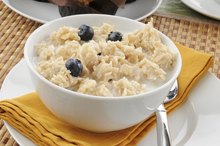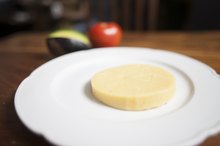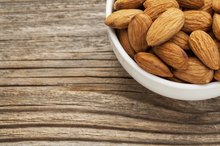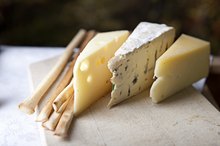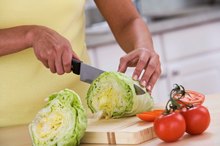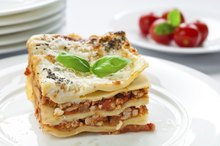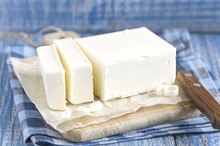What Are the Food Groups in a Cheese Sandwich?
A cheese sandwich can be a meal on its own or might be an accompaniment to soup or salad. Cheese sandwiches can vary widely -- and the food groups they contain and their nutritional composition depends on how you make them. Choose healthy ingredients to get the most from your cheese sandwiches.
Build Strong Bones with Dairy
Cheese is in the dairy group, which also includes milk and yogurt. One serving of cheese consists of 1 1/2 ounces -- and most children and adults should consume three servings per day. Cheese and other dairy products provide protein and calcium, which is an essential mineral for bone health. Choose low-fat or fat-free cheese to limit your consumption of calories and cholesterol-raising saturated fat.
- Cheese is in the dairy group, which also includes milk and yogurt.
Fight Chronic Diseases with Whole Grains
Good Carbs to Eat for Breakfast
Learn More
Most cheese sandwiches contain one or more servings from the grains group, which includes sliced bread, rolls, buns and crackers. The Dietary Guidelines for Americans, 2010 suggests getting at least half of your grains from whole-grain sources to help manage your weight and lower your risk for heart disease 2. To help you achieve this recommendation, use whole-grain sliced bread, rolls, English muffins, bagels or crackers for your cheese sandwiches. Choose crackers that are free from partially hydrogenated oils, which typically contain unhealthy trans fats.
- Most cheese sandwiches contain one or more servings from the grains group, which includes sliced bread, rolls, buns and crackers.
- The Dietary Guidelines for Americans, 2010 suggests getting at least half of your grains from whole-grain sources to help manage your weight and lower your risk for heart disease 2.
Pack in Extra Nutrients from Fruits or Vegetables
Add fruit or vegetables to your cheese sandwich to increase its content of dietary fiber as well as vitamins and minerals. Eating fruits and vegetables can help lower your risk for obesity and Type 2 diabetes. Make a high-fiber toasted sandwich with grilled eggplant and red peppers and low-fat provolone cheese on a whole-grain roll, or wrap low-fat feta cheese, alfalfa sprouts and diced tomatoes in a whole-wheat pita. For breakfast, try low-fat cheddar and sliced apples on a whole-grain bagel. If you are on a low-carbohydrate diet and using lettuce or slices of grilled eggplant in place of bread for your cheese sandwich, your sandwich will contain an extra serving of vegetables but no grains.
- Add fruit or vegetables to your cheese sandwich to increase its content of dietary fiber as well as vitamins and minerals.
- Make a high-fiber toasted sandwich with grilled eggplant and red peppers and low-fat provolone cheese on a whole-grain roll, or wrap low-fat feta cheese, alfalfa sprouts and diced tomatoes in a whole-wheat pita.
Use Fats to Your Advantage
Does Provolone Cheese Have Less Fat Than American Cheese?
Learn More
Full-fat cheese is a top source of saturated fat in the typical American diet, but you can lower your consumption by choosing reduced-fat cheeses. Spreads, such as butter, are additional possible sources of unhealthy fats on a cheese sandwich, but healthier options are possible. Choose healthy fats to lower your cholesterol levels and risk for heart disease. For example, try avocado slices and low-fat Swiss cheese on whole-grain rye bread, or spread guacamole on a whole-wheat tortilla to wrap low-fat, Monterey Jack cheese, tomatoes and lettuce. Nuts are also high in healthy fats -- and a walnut and goat cheese sandwich is a tasty combination.
- Full-fat cheese is a top source of saturated fat in the typical American diet, but you can lower your consumption by choosing reduced-fat cheeses.
- Spreads, such as butter, are additional possible sources of unhealthy fats on a cheese sandwich, but healthier options are possible.
Stay Full with Protein
Cheese sandwiches can contain high-protein foods in addition to cheese. Lean ham, sliced turkey breast and sliced chicken breast are common protein options that can go well with nearly any cheese. Tuna with Swiss cheese and sauerkraut is another tasty option. Choose low-sodium deli meats and avoid fatty meats such as bacon, salami, pepperoni and breaded chicken. A breakfast sandwich might include egg whites, low-fat mozzarella cheese and spinach leaves on a whole-grain English muffin.
- Cheese sandwiches can contain high-protein foods in addition to cheese.
- A breakfast sandwich might include egg whites, low-fat mozzarella cheese and spinach leaves on a whole-grain English muffin.
Related Articles
References
- U.S. Department of Agriculture: Choose My Plate: Food Groups
- U.S. Department of Agriculture and U.S. Department of Health and Human Services: Dietary Guidelines for Americans, 2010
- Cheese, swiss. FoodData Central. U.S. Department of Agriculture. Published April 1, 2019.
- Cheese, part skim mozzarella. FoodData Central. U.S. Department of Agriculture. Published April 1, 2019.
- Cheese, parmesan, grated. FoodData Central. U.S. Department of Agriculture. Published April 1, 2019.
- Cheese. FoodData Central. U.S. Department of Agriculture. Published April 1, 2019.
- Nilsen R, Høstmark AT, Haug A, Skeie S. Effect of a high intake of cheese on cholesterol and metabolic syndrome: results of a randomized trial. Food Nutr Res. 2015;59:27651. doi:10.3402/fnr.v59.27651
- Rozenberg S, Body JJ, Bruyère O, et al. Effects of dairy products consumption on health: Benefits and beliefs--a commentary from the Belgian Bone Club and the European Society for Clinical and Economic Aspects of Osteoporosis, Osteoarthritis and Musculoskeletal Diseases. Calcif Tissue Int. 2016;98(1):1–17. doi:10.1007/s00223-015-0062-x
- de Goede J, Geleijnse JM, Ding EL, Soedamah-Muthu SS. Effect of cheese consumption on blood lipids: a systematic review and meta-analysis of randomized controlled trials. Nutr Rev. 2015;73(5):259-75. doi:10.1093/nutrit/nuu060
- National Heart, Lung, and Blood Institute. Food exchange lists.
- Dairy Products - Milk, Yogurt, and Cheese. American Heart Association. Reviewed April 16, 2018.
Writer Bio
Natalie Stein specializes in weight loss and sports nutrition. She is based in Los Angeles and is an assistant professor with the Program for Public Health at Michigan State University. Stein holds a master of science degree in nutrition and a master of public health degree from Michigan State University.
